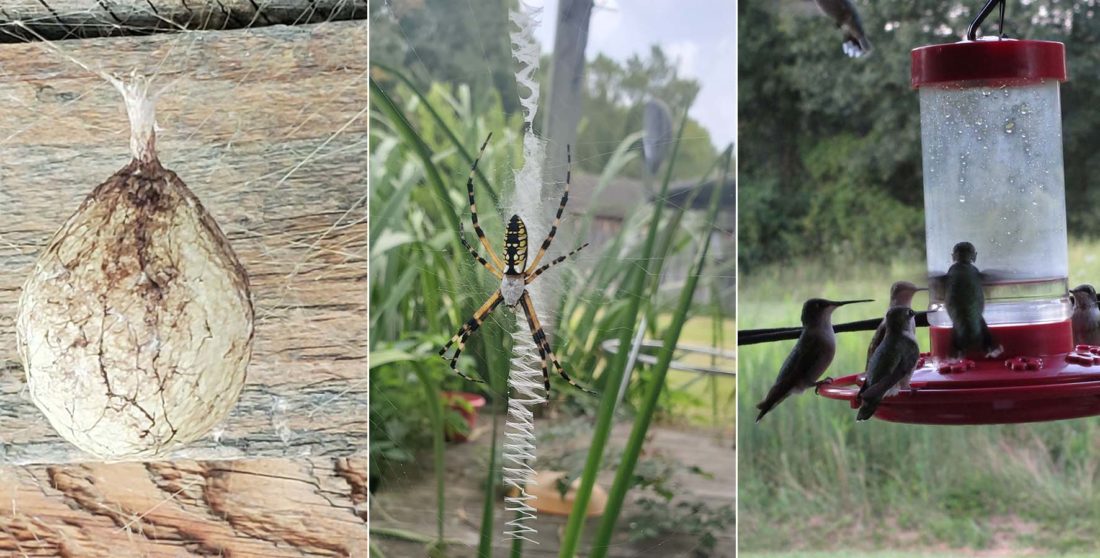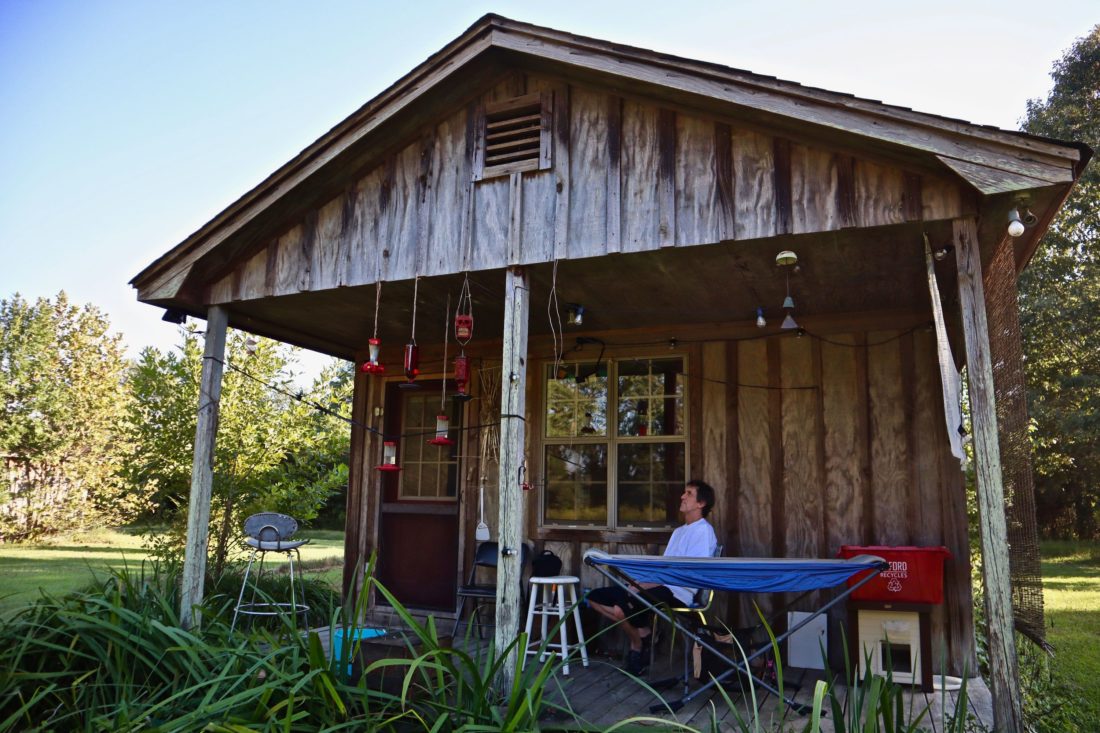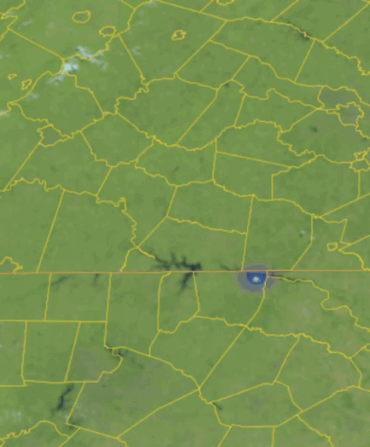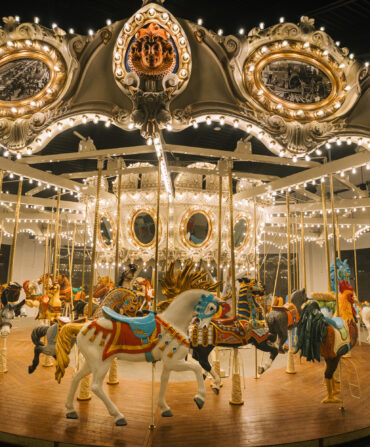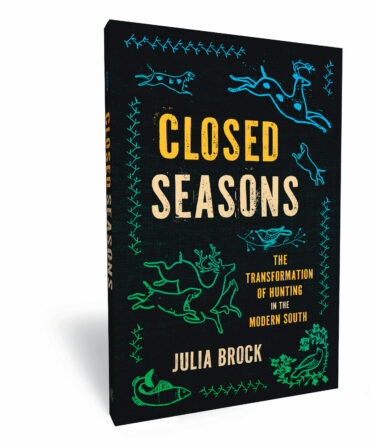I was living in this cinderblock shanty, an old servant quarters listing into a ravine on the north shore of Bailey’s Woods opposite William Faulkner’s house. My rent was cheap, it was a two-block stumble from the bars, and I’d been happily sinking into the ravine for a decade when some retired doctor started buying up the neighborhood, each project moving closer to my hovel, and sure enough one day I got the notice to vacate. Gentrification balks at no man yet I could not bear the thought of abandoning my ravine thick with critter: fox, groundhog, possum, coon, plus a herd of deer that had adopted me. When a neighbor explained that my home was to be converted into a rich man’s pool house, steam blew out both my ears. That seemed typical of Oxford, a once Bohemian town, maybe the only one in Mississippi history, which was micromanaging itself into a retirement community with a cop in every rearview. It was time to leave, and I had the papers to prove it.
Most of my friends had already fled. Soaring rents scatter worthwhile writers faster than cops do. Although Oxford’s tourist industry continued to advertise its writers like plastic mascots in a theme park, Faulknerland, the same city that marketed us had no interest in providing affordable housing. While sullenly boxing books, I glanced out the window at my deer tribe. So many mornings I’d stagger into my kitchen to find a dozen does congregated in the ravine with fawns underfoot. The bucks were more skittish. I’d watched them through the windows rearing up and battling antlers, but the moment I stepped outside they took flight whereas the does only glanced up balefully, pausing to use telepathy to entice me into throwing them grapes or cherry tomatoes. Deer herds tend to stay within a mile or so radius their entire lives, meaning I’d known their great grandparents. Every deer in Bailey’s Woods recognized me from when they were spotted fawns spying between mom’s legs at the weirdly upright creature who tossed them blackberries. Well, that chapter was closing. Doctors need pool houses, after all.
Exiled, I left Oxford that June and moved to the town of Taylor, where my friend Jane Rule Burdine had offered me one of her rental cabins. Though only a twenty-minute drive from my old digs, Taylor felt worlds away. The land was flat like in the Delta and the colors rich with hardwood. My cabin stood in a field facing north into a line of magnificent oak crowns. After U-Hauling my belongings there, I returned to the ravine to say goodbye to the critters. You can keep your majestic lion but give me that moonlit armadillo who tagged beside me for two blocks on my slant home from the bar at Ajax Diner. I stood in the ravine weeping like a child while using the telepathy the deer had taught me to say goodbye, then I corralled my cat, Bandit, and left the ravine forever.
Bandit, who had grown up feral, went postal our first night in the cabin, and the next morning I made the mistake of letting him out onto the porch. He bolted, came back for dinner a few times, then vanished. At night I’d sit on my porch listening to coyotes cackle on the far side of the tree line. Come dawn I’d wander the field clapping and calling after Bandit while watching myself through the windows of nearby cabins. My new neighbors were probably sick of me already, but I’d lived a solitary life and that cat was my brother.
I started drinking too much. Well, I’d always been drinking too much, but now I drank without bounds. Alcoholism, and alcoholic suicide, ran deep in the Durkee bloodline. Then one hungover morning I absently double-clicked an article about alcohol intolerance. My father had suffered horribly from that genetic condition before killing himself on pills and booze. Decades earlier my grandfather had hanged himself from a tree. I’d always known alcohol intolerance was hereditary, but such was the power of denial that I had never looked into it before. Now I read the online article with rising horror. People who lack the enzyme that breaks down alcohol often suffer from asthma, and asthma had been the bane of my existence. Likewise, the article said, they have low blood pressure and often endure esophageal issues with throat cancer on the way if the brain cancer doesn’t get them first. Suddenly I understood my own maladies as well as my father’s early dementia, and I also learned that cirrhosis of the liver likely loomed in my future along with Alzheimer’s. Denial is the perfect wingman until he gets you killed. Something had to give. I was playing foosball with death.
So it was I swore off booze and took to hummingbirds. My mom used to hang a feeder, and I’d grown up in awe of those tiny, impossible creatures that seemed otherworldly to a child obsessed with ghosts and UFOs. But since we’d only had one feeder, some bully was always guarding it, a problem I solved by hanging three feeders on my new porch. After that I kept buying extra feeders with money previously spent on booze. (Bar tabs had been my highest utility.) When I had eight feeders lined up, the hummers started flocking down: twelve, twenty, fifty, and twice that number perched in the nearby sapling my neighbor Clay called a coyote willow. That once lonely tree, now electric with shimmering fruit, was connected to my porch by a superhighway of blurred birds that at dawn and dusk resembled power lines.
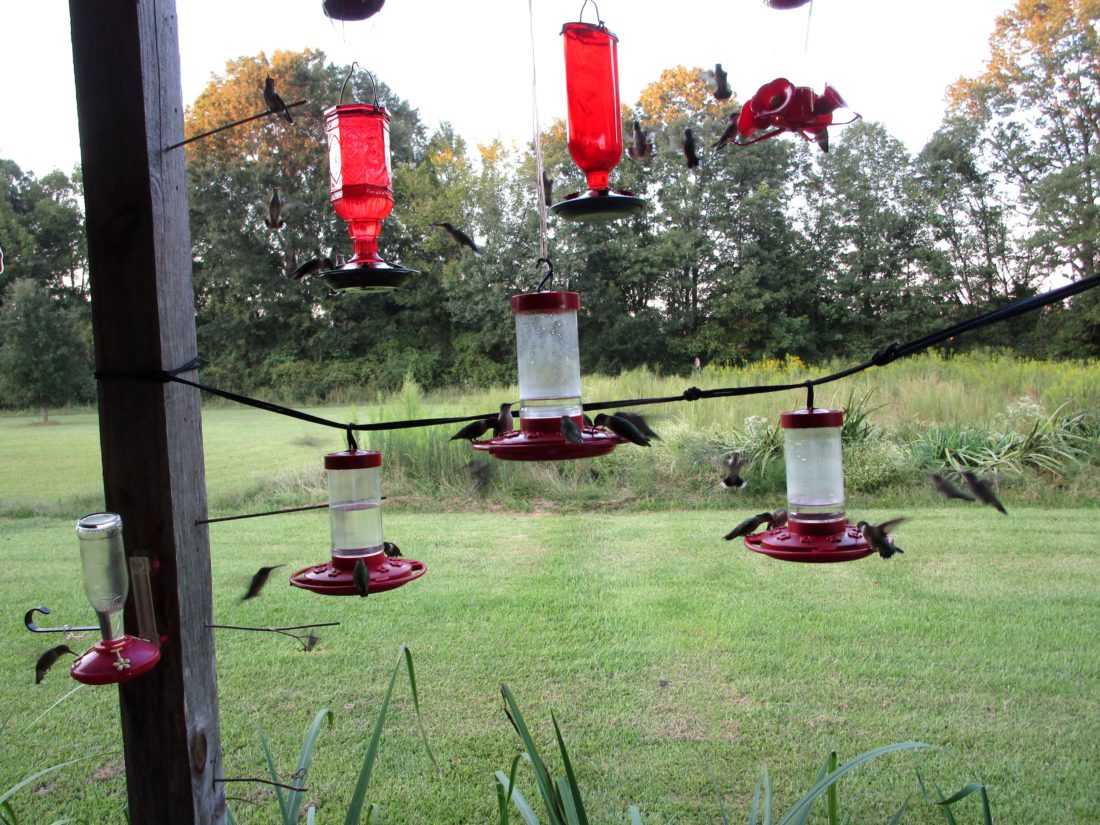
As with deer and humans, the female birds seemed fearless compared to the males and would harry around my hair whenever their feeders ran dry to remind me of my purpose in life. All critters are curious, and these ruby-throated wonders, one of the tiniest animals alive, enjoyed hovering in front of my face and examining me from all angles. “Life delights in life,” William Blake once said, and he was right. When my feeders lacked birds, all I had to do was walk outside and within seconds twenty birds would be dancing around me like in a Disney film. I half expected them to break into song. Sometimes I pretended the birds were my cat Bandit divided into a hundred shimmering puzzle pieces come back to visit me.
I started posting videos of the birds onto my neglected Instagram feed. Or sometimes I’d hit the live-stream button and leave the camera running on my feeders. Then one day, along came a spider and things got interesting. This outsized garden spider, known as a golden silk orb weaver (ahem), set up shop in the upper reaches of the porch among the feeders. Was she hoping to capture a hummer? I doubted that but named her Ahab anyway and posted a photo of her online only to discover that spiders were not especially popular in social-media circles. But I’d always admired garden spiders, which were called “writer spiders” due to their telltale zig-zagging web centerpiece signature.
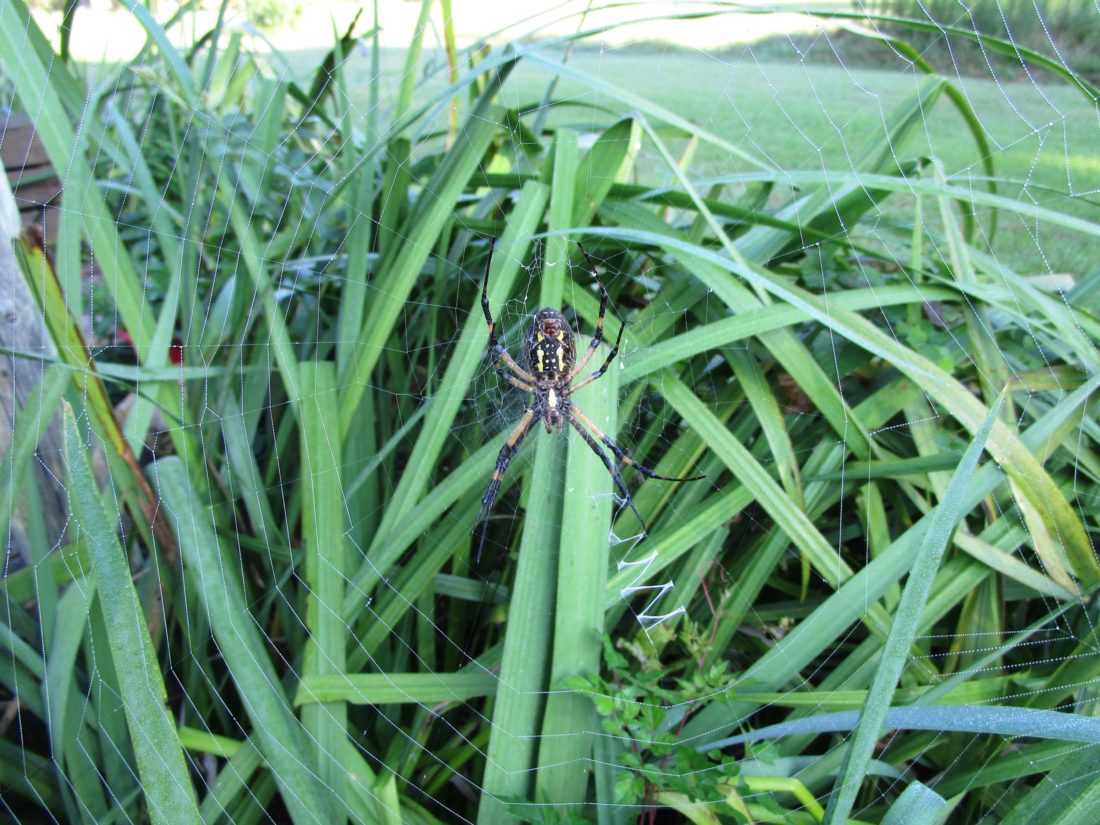
Was Ahab actually trawling for hummingbirds? If so, I considered it a folly, a word I’d become obsessed with after reading a friend’s article about the anti-logical backyard structures of that name. Of late I’d started seeing follies everywhere. My whole drunken life now seemed a folly. I started referring to Ahab’s silken hammock, hung directly above my porch hammock in bunk-bed fashion, as “Ahab’s folly.” One day while I watched her web, a hummingbird torpedoed right through it and left a gaping hole in its hull. Ahab instantly ate the damaged strands—ingesting any nutrients stuck there—and went to work rebuilding.
“Told ya,” I said to her.
Like Ahab, I too was constantly rebuilding. Two, then three months free of booze, pills, and smoke transformed me to the point I gaped into the mirror with the same fascination I had gazed into Ahab’s eight eyes. Who was this strange critter? Scars I accumulated in my wild-eyed teenage years had healed away. I could eat any type of food now without choking. My long-range vision kept improving, while my hair curled into the top-heavy coif favored by evangelical preachers. I slept at nights and had weird dreams about hummingbirds.
I am anything but a materialist and hold to the more mystical theories of creation. Native Americans, especially the Hopi, revered the spider for obvious reasons and considered hummingbirds to be messengers from the spirit world associated with the gifts of rain and fire. The more I learned about hummingbirds the more I came to agree with the Native American belief that they’d been created by flowers. Even science conceded that plants had fashioned these birds to comport to the eccentric shapes of certain bells and trumpets in need of pollination at the higher altitudes of South America where insects faltered. The 8,000 species of plants which relied on hummingbirds for reproduction had given birth to a symbiotic species with bizarre beaks mirroring the shape and depth of eccentric flowers while perfecting a wing system that allowed flight in any direction or angle, even in headwinds. There were countless articles online about the hummingbird heartbeat and wing speed but if you stepped back beyond the yaw of numbers, you started to glimpse a greater truth that the Hopi and William Blake had both understood: These creatures are divine, a gift to humankind, and a work of art that prove there is more to heaven and earth than was dreamt of in Darwinian philosophy.
Darwin himself would have needed a stiff drink upon learning (according to Scientific American) that in the blink of an evolutionary eye, a mere 22 million years, which is nothing, 338 different species of hummingbirds poured out from their ur-ancestor. Apparently these birds do everything at break-neck speed, and science cannot begin to explain how the hummers pulled off this time-lapse shapeshifting miracle that thwarts everything we pretended to know about the origins of species. Although scientists will never admit hummingbirds are impossible, the eye knows that instantly, and delights in it.
As more birds swarmed my porch, an emerald cloud of jousting flashes of crimson, I found it difficult to keep them out of my cabin. Some days I’d be writing away with three birds circling overhead. I’d wait for them to tire themselves out before capturing them inside a baseball cap to release them. And one afternoon I walked into my kitchen just as a mouse scurried past my feet. Except it wasn’t a mouse, it was a floor-bound male hummer, his burnished scarlet throat pulsing like he’d swallowed a firefly. When I tried to capture him, he took flight but couldn’t gain altitude. I picked him up and frisked him and he appeared undamaged. Assuming he was concussed, I held him for ten magical minutes cooing at him while he stuck his long proboscis into the air. Trembling, he climbed onto my finger and perched there another five minutes before taking flight and attaching himself to the screen door. When I pushed the door open, he followed the curve of my grin and shot into the coyote willow.
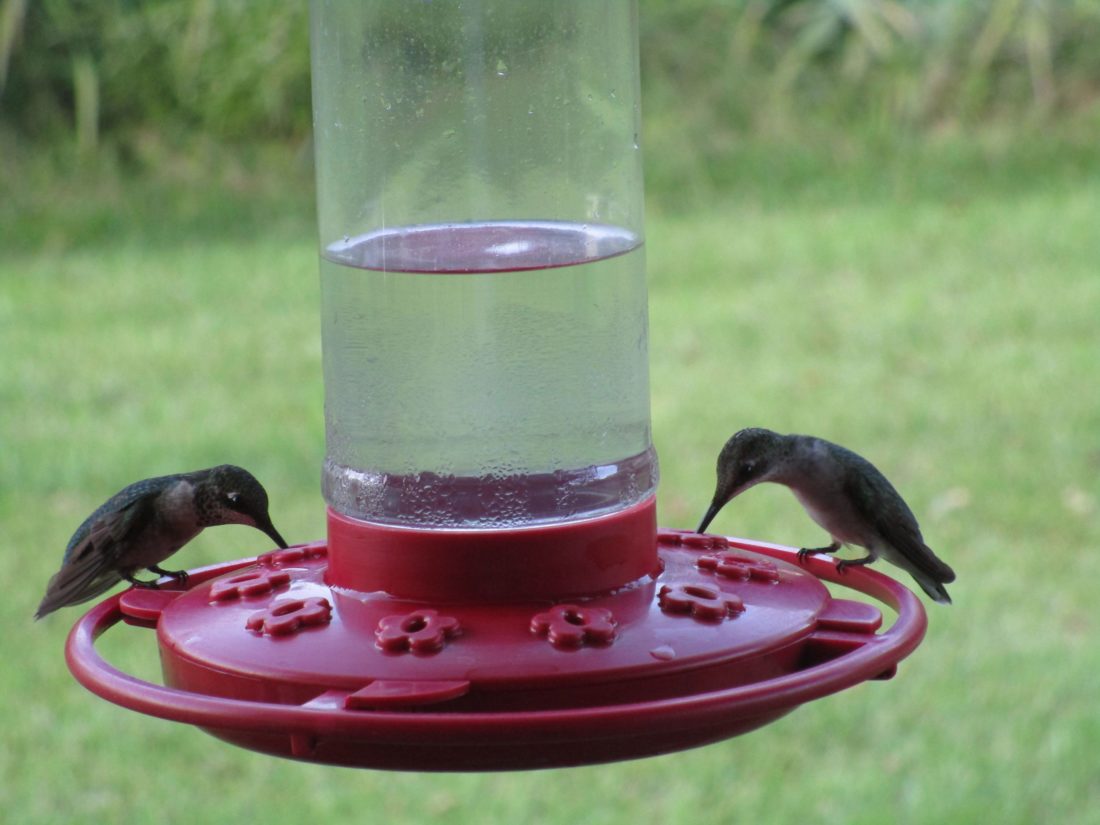
Something even more astonishing occurred when a hummingbird flew into Ahab’s net and became snared inside it. Her web still bouncing from the impact, Ahab appeared horrified at her success and crouched in a corner above the flailing bird. The speed with which I pulled the bird free caused a tear along her white-rimmed tail fan. For the next five minutes I spit-shined her feathers clean of the web gunk that hummers use to build their miniscule nests, then I blew her trembling body dry, released her, and she flew off. Although she seemed fine, I did worry those torn tail feathers might hamper her on the 500-mile migration across the Gulf of Mexico in September.
I should have evicted Ahab at that point, but I was fond of her and convinced myself it had been a fluke. Although Ahab had showed no interest in the captured bird, the birds now had an obsessive interest in her and took turns hovering in her face and sometimes parried with her. I was sitting on the porch losing a game of online chess to my son on the afternoon a second female hummer got snagged in Ahab’s lair. I wasn’t as alarmed this time and pushed the video button on my phone as I walked toward the flailing bird (I would be greatly castigated for this later) and was glancing into the camera’s viewfinder when horror struck. Ahab attacked, dropping down with terrifying speed to guard her prey. Apparently she had resented my stealing her meal and was willing to fight me over this one. The jagged movement of jointed legs transformed Ahab into a Halloween villain, and I dropped the phone and had to steel myself before wrangling the bird from her clutches.
After bluffing her into retreat, I removed the bird by taking down certain web strands. I set the bird free, and later, after my heart quit pounding, I posted the five-second video while Ahab glowered at me. I apologized as I began taking down her web, but instead of eating the strands this time, she dropped onto the porch next to my bare feet with alarming alacrity. I thought she was about to attack and could feel the anger radiating off her over my betrayal. We’d been friends, after all, and she’d earned that meal. I picked up a broom and gently brushed her into the swamp iris lining the porch.
She returned that night and come morning was perched in the same spot sporting a new web gleaming with dew. I took it down and brushed her off the porch again. The following morning I found her positioned above the porch door. I brushed her off the porch one last time, finished my coffee, then went online and saw, to my shock, that my brief video of Ahab’s attack on the flailing bird had gone viral. Thousands of people had “liked” and commented on it. Most of these comments, punctuated with spider emojis, screamed for Ahab’s head: “KILL THE DAMN SPIDER!” Countless methods of killing Ahab were suggested. More than one post suggested I burn down the entire cabin. Other trolls insulted me for interfering with nature’s plan, but was I not a great ape and therefore a part of nature, too? Finally there was the contingent who insisted I’d rubbed my hands together gleefully while watching the spider devour the still alive hummingbird—or perhaps I’d eaten the bird myself. Almost everyone agreed I was damned to hell for having shot a five-second video of the suffering bird.
Accused of posting a hummingbird snuff film, I started defending myself but soon realized that was useless. Spiders are gonna spider and trolls are gonna troll. Meanwhile the “likes” were growing exponentially. It took two weeks to reach ten thousand but only one more day to reach twenty thousand. By then, web companies were contacting me for video rights while agents emailed me promises of split profits if I signed the attached contracts. As the direct messages piled up, one person asked if they could drive to Mississippi to make a pet out of Ahab. Online newspapers started running articles about Ahab, complete with my photographs, in languages I could not even identify. A star is born, both beloved and reviled.
As my meager Instagram following tripled, my birds started tapering off until I was down to a gallon of nectar a day and began to brace myself for the solitude of winter. By now I had accepted my cat Bandit was not coming home and I started scouring the police lineup of cat mug shots on the humane society web page. A critterless winter would crush me, I knew. The solitude of sobriety is not easy, especially in a new town.
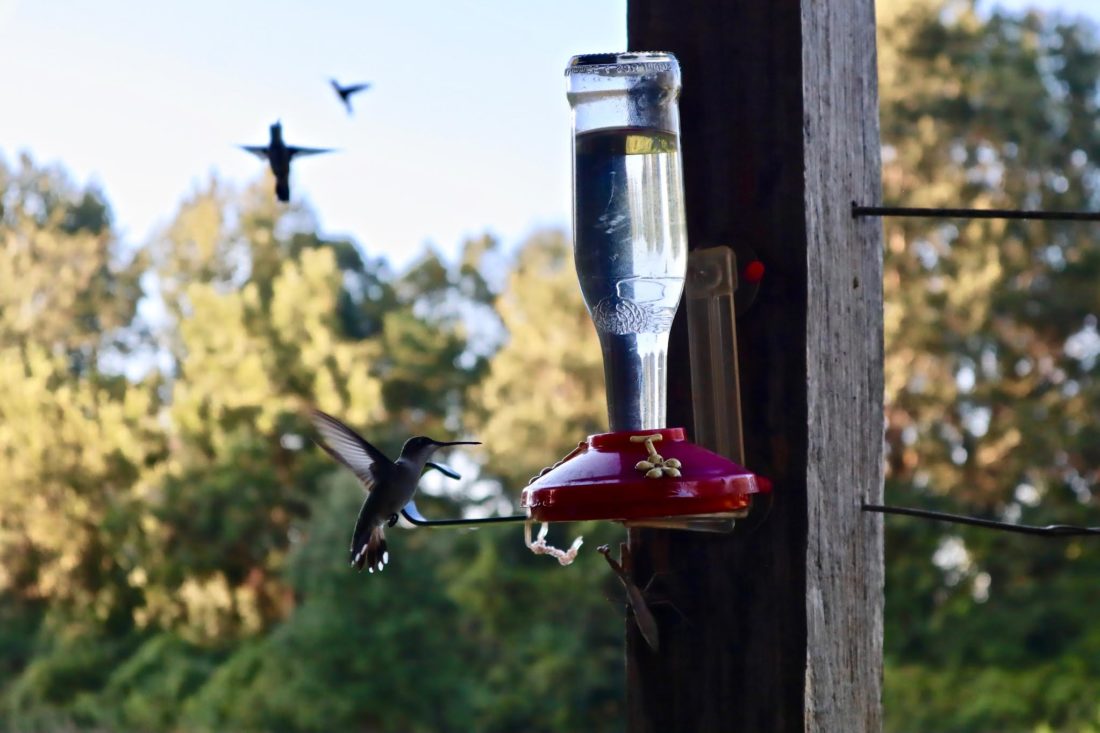
I was down to about twenty birds on the morning I walked my coffee onto the porch at sunrise to find a gift left for me there. A week had passed since I’d last seen Ahab, but when I searched around for her, as I did every morning, I instead spotted a beautiful egg sack, the size and shape of a robin egg, hung inside a furry web above my screen door at the same spot Ahab had last been seen. Then, once the sun had risen, I glimpsed a glimmering something in the swamp iris, a concave web beaded by dew with Ahab perched like a jewel in its center. I grinned from Ahab to the egg sack. As a kid I had poked a stick into just such an egg sack and then watched with fascination and horror as hundreds of baby spiders poured into the world.
